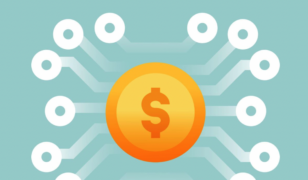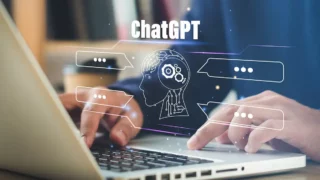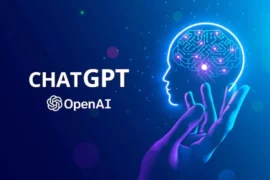13 Ideas For Using ChatGPT In Your Online Business
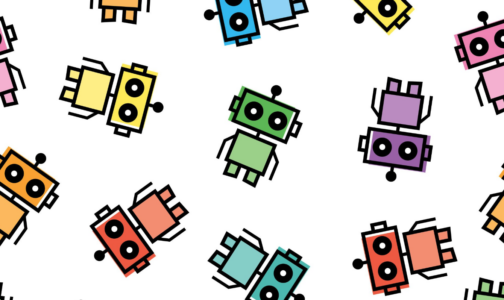
Today, I felt like taking myself outside the box, err inside the box nowadays to discuss some wild and not so wild ideas for using artificial intelligence in your online business. Specifically using the brand new, terribly popular GPT-3.5 / GPT-4 models that drive ChatGPT.
With the newly released GPT-4 driving, ChatGPT has made the impossible possible and few sectors are positioned to take advantage of this awesome new technology better than that of online business. Why? For a few reasons.
Why Use ChatGPT In Your Online Business?
Most online businesses already revolve around software, so creating API calls to the GPT 3.5 or soon to be GPT-4 API is relatively easy and at worst modestly difficult. Another reason for implementing ChatGPT? Minimal cost.
The cost of implementing OpenAI’s new GPT engines is modest. Sure, GPT-4 costs much more than GPT-3.5 which costs much more than the older models, but the costs are variable. You pay per 1,000 tokens, so if you implement AI and capture value on the other end, the costs are more than covered. If you don’t use it much, you don’t pay much.
How Can I Use ChatGPT In My Online Business?
Millions of different ways, that’s how. Okay, maybe not millions of ways, but probably a single million ways. But, I’m one man and have practically no free time, so I’m going to throw just a handful at the wall in this article and see what sticks. Let’s jump in and start talking crazy online business AI ideas.
Use ChatGPT to:
- Generate Content
- Rewrite Content
- Perform SEO Analysis
- Translate Content
- Screen and Score Resumes
- Generate & Submit Resumes Crafted to The Job Description
- Recruit Employees
- Create and Automate Ad Copy
- Personlize Your Website (coming soon)
- Improve Accessibility For The Visually Impaired (coming soon)
- Perform Financial Analysis (coming soon)
- Categorize and Write Emails (coming soon)
- Automate Website Error Handling (coming soon)
Idea #1 – Use ChatGPT To Generate Content
Most online businesses deal in content in some form or fashion. Useful content gets your business’ webpages in prime positions in Google which in turn gets clicks to your site which translates into website visitors. Visitors who potentially start a subscription, buy your product, click your ad, grow your brand, etc. But writing useful content in large volumes isn’t easy or cheap. Enter ChatGPT.
ChatGPT can generate high quality content for your products, blog articles, social posts, email newsletters, and much more. Here is an example. I want to create a fully automated newsletter about entrepreneurship and send it to my audience once per week. I can simply ask ChatGPT to generate a newsletter with 5 blog posts about entrepreneurship and include links to the post. Here is what ChatGPT returned.

It wrote the entire newsletter, including choosing the topics, but it didn’t insert the links to real blog posts. It instead inserted [Link insert link to post] placeholders. I love this! In seconds, I’ve generated a captivating newsletter. Now, I can quickly browse the internet searching for each blurb, find the top-rated or best articles for each, manually insert their links, and send the newsletter.
Better yet, let’s see if ChatGPT can give me each of the links. Remember though, it only understands webpages and content from 2021 and earlier, so we might get old articles. I used blurb #2 in the newsletter to ask ChatGPT to give me the url to a great article about The Power of Networking in Entrepreneurship.

Voila! It gave me https://www.entrepreneur.com/leadership/deepak-chopras-7-tips-for-business-success/282057. Within seconds I created a compelling newsletter with links to send to my audience. If you are in the game of generating content for an audience, exploring ChatGPT is a must.
Idea #2 – Use ChatGPT To Rewrite Content
We just discussed using ChatGPT to generate, or create content, but it’s also prime for rewriting content.
I know what you’re probably thinking. People only rewrite content to plagiarize other peoples’ work, but this couldn’t be further from the truth. Reputable online businesses across the spectrum regularly rewrite content using actual, real life writers and editors at great expense. This is because many online businesses report off of news, research, and other source content that was originally written by a single writer.
Instead of having a team of writers and editors who rewrite source content for your website, use ChatGPT. When rewriting content, the goal is typically to put your spin on the news for your audience.
ChatGPT can do this just as well as a human can. This wasn’t necessarily the case with GPT-3, but with ChatGPT 3.5 and 4, the game has changed.
I now give you a small example of using ChatGPT to rewrite content. I have taken the above paragraph that starts with the sentence I know what you’re probably thinking and asked ChatGPT to rewrite it in a humorous tone. See the results for yourself.
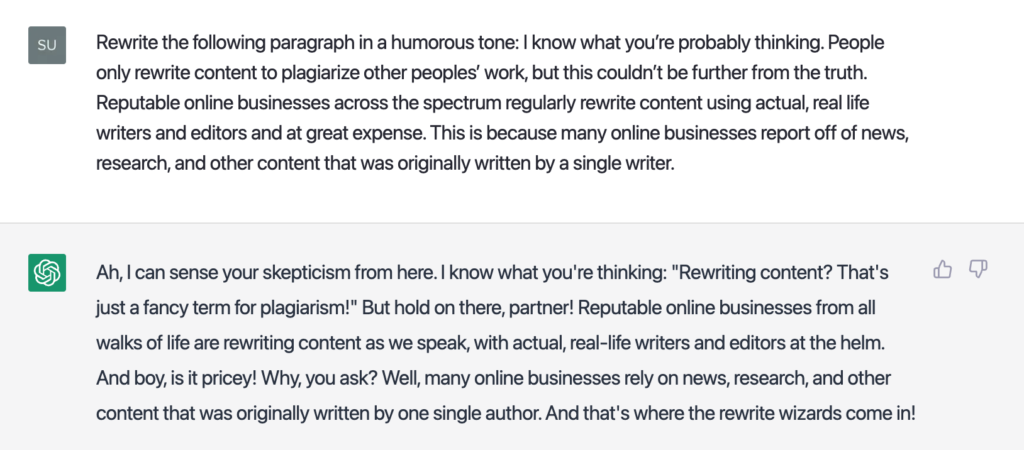
ChatGPT nailed it. Read through the two above paragraphs carefully and you’ll see that the first paragraph was not plagiarized. It was truly rewritten to be in our, or ChatGPT’s, own words. All while conveying the same meaning as the original paragraph. This is no different than what myriad content creators, writers, and editors do on a daily basis as part of their jobs. AI is a game-changer here because when it comes to rewriting content, a strong case could be made that GPT-3.5 and GPT-4 are actually better writers than humans.
Idea #3 – Use ChatGPT For SEO
I have a full article on experimenting with ChatGPT for SEO, so I won’t rehash it all here. Rather I’ll just touch the subject.
Today, you must use many tools to perform search engine optimization, (SEO) analysis. Tools to discover keywords and search volumes, tools to discover and analyze backlinks and referring domains, tools to analyze competing search engine results pages (SERPs), tools to optimize your content, and on and on. The world of SEO is a world of disparate tools, most with overlapping but different feature sets. ChatGPT could change all that and allow us to use a single tool for everything; it. It could even kill the practice of SEO as we know if ChatGPT replaces search engines.
Idea #4 – Use ChatGPT To Translate and Localize Content On Your Website Content
Our online business wordbot (not this blog, but that SaaS) allows users to generate and rewrite content in over 100 languages. How do we do it? With the Google Cloud Translation API. We attempted to use GPT-3 when we first added translation about 12 months ago, but at the time it wasn’t near as good as Google’s translation API. But as Bob Dylan once sang, times are a changing my friend.
Another translation example – I currently run IT and Ops at an online business that has a website with a reach of over 40 million per month – a big time outfit. Our website is a custom-designed WordPress theme with a Node.js and Mongo stack for data warehousing. But I digress.
For translation, we use a plugin called Weglot. It translates any website text on the fly and then stores those translations and reuses them for new content. The plugin is far from perfect, but works rather well. It’s also crazy expensive for the levels of volume we have.
The GPT-3.5 API which powers the free ChatGPT and the GPT-4 API which powers the Pro version are not free and at large volumes are certainly not cheap. So there are still cost considerations when considering using it to translate text at large volume. But here is why I think using ChatGPT to translate text instead of Google Translate or a plugin like Weglot makes a lot of since – localization.
Localization is the process of making something local in character or restricting it to a particular place. Translating a phrase is one thing, but localizing it is another. Localization is VERY expensive and typically only the largest corporations can afford to do it. Think Netflix, Paramount, and other huge corporations that serve content in many countries and must nail the localisms to make their content high quality and engaging.
I suspect moving forward, ChatGPT will translate and localize content at a far better clip than today’s tools that typically only translate. With all this said, here is a quick example of using ChatGPT to translate this paragraph into Spain dialect of Spanish and then Mexican dialect of Spanish.
Spain Dialect
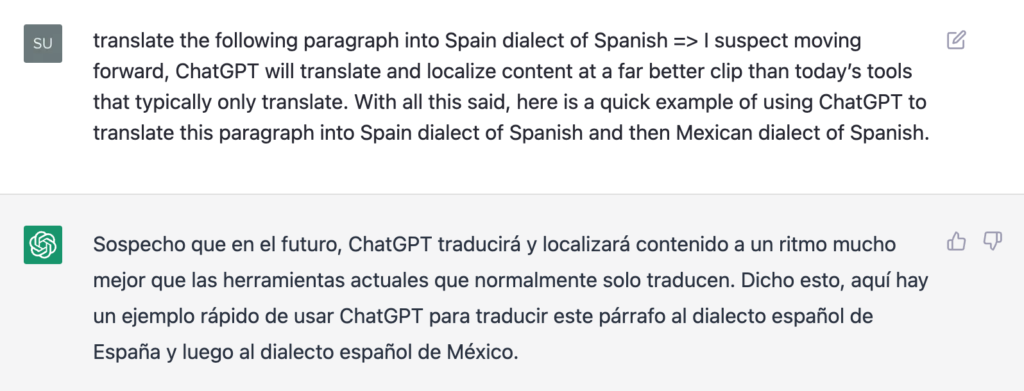
Mexican Dialect

I can’t speak Spanish and certainly don’t understand the differences in dialect, but if you study the above images you’ll see they’re the same. Should they be the same for Spain and Mexico? I don’t know. Either yes they should be or no they shouldn’t and ChatGPT didn’t localize. Or my question needs tweaked. I won’t try and address the situation here, but rest assured in the future, the GPT suite of AI models will support localization and commoditize a very expensive benefit currently reserved for wealthy businesses.
Idea #5 – Use ChatGPT To Screen & Score Resumes
Before I jump into this one, let me state that I’m well aware of the biases in artificial intelligence including OpenAI’s ChatGPT and family of other GPT models. When using AI for screening things like resumes, which come from a very diverse group of individuals, consideration and caution definitely need to be used to ensure you’re not discriminating against candidates or killing your business’ hard earned diversity. With that said, here’s my idea.
I’m an IT Executive by trade. In the last 12 months, I’ve hired two developers and a data analyst. For each of these positions, I literally reviewed 400+ resumes. Uff. Let me just say, in these situations I didn’t have the time to review hundreds of resumes, which meant I spent my nights doing it. As AI started picking up steam, I asked myself “there has to be a better way”.
The company I’m at now uses Rippling, a very well known tech all-in-one HR platform. Part of their product is ATS, or Applicant Tracking System. I reached out to them and asked if they have AI to screen resumes, and they said they’re exploring it.
There is a huge, huge opportunity here to save yourself hundreds and hundreds of hours across your hiring team by using AI to screen and score resumes based on work skills and core values. I’ve experienced this pain so much, that I personally have considered creating a startup that specializes in this, but I digress. Let’s see how ChatGPT does with a really simple experiment.
I pretend to have a position for a software developer. I state that we use React, Node.js, and MongoDB for our tech stack. I tell ChatGPT that my company’s core values are trust, teamwork, and striving for excellence. Lastly, I state that I want people with 5 years experience and ask ChatGPT to give me a resume quality score of 1 – 5, with 1 being the best. I feed it an extremely dumbed down resumed to see what score it gets.
Below is the conversation with ChatGPT.
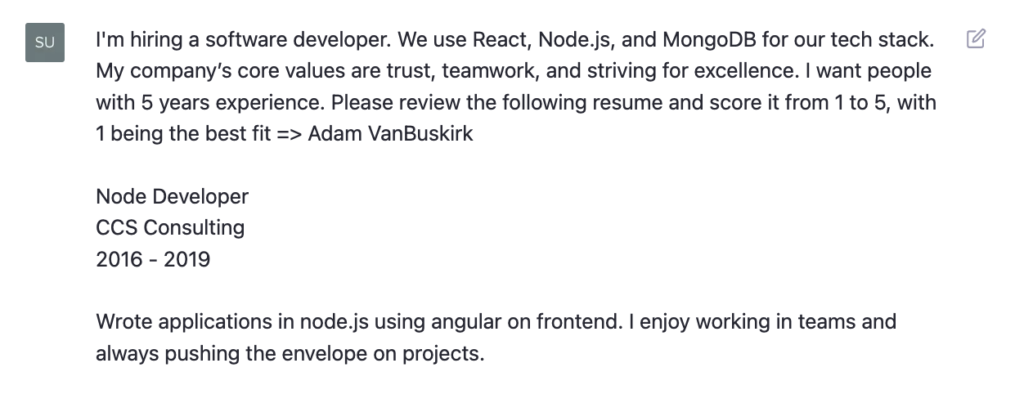

I obviously dumbed the resume down hard for this example, but ChatGPT came through. It reviewed my requirements, scored my resume 3 out of 5, and made a list of pros and cons. It stumbled on the experience, stating that the resume didn’t list years of experience when it did in fact include a date range for the job.
Unbelievable results for me spending five minutes experimenting with it. We can easily see how taking time to craft our questions and interactions with ChatGPT we could paste in resume after resume, get scores, and then review only the top-rated resumes.
This article is a work in progress, coming next…
Idea #6 – Generating & Submitting Resumes Crafted to The Job Description
This one is more for the job seeker than the online business owner, but I feel so passionately about it, I just had to include it. I mentioned earlier that I’ve been spending an exorbitant amount of time combing through resumes. Most of those resumes go directly in the trash bin because the job seeker made no effort to tell me how THEIR SKILLS CAN HELP OUR BUSINESS. If you want to land the awesome jobs, you have to customize your resume to the job.
I get it, doing that takes time and lots of it. When you’re applying to dozens of jobs and probably mixing in some interviews, rewriting your cover letter and resume to each job description is insanely time consuming. At least, it used to be. Not so much anymore with ChatGPT.
Here is my premise, which I have actually done in ChatGPT and it works! Take your resume and paste it in saying this is my resume. Take the job description and paste it in saying it’s a job description. Then, tell ChatGPT to take your resume and rewrite it to the specific job description.
It will rewrite your resume to the job description. You can now start pasting job descriptions into ChatGPT and get custom resumes out. A huge, huge time saver and guaranteed to get you way more interviews.
Here’s another approach you can take which I’ll show below because I don’t want to use my actual resume in the example. This method involves more manual work, but is arguably even more effective. Simply paste in the job description and ask ChatGPT to make you a resume that will get you hired. Then fill in your details after the fact. Let’s do this now. I simply went to ZipRecruiter and searched WordPress Developer and grabbed one of the first job descriptions I found for a developer in Cleveland, OH. We’ll pretend I’m a WP Developer looking to nail a resume for this job description.
See the Q&A with ChatGPT below.
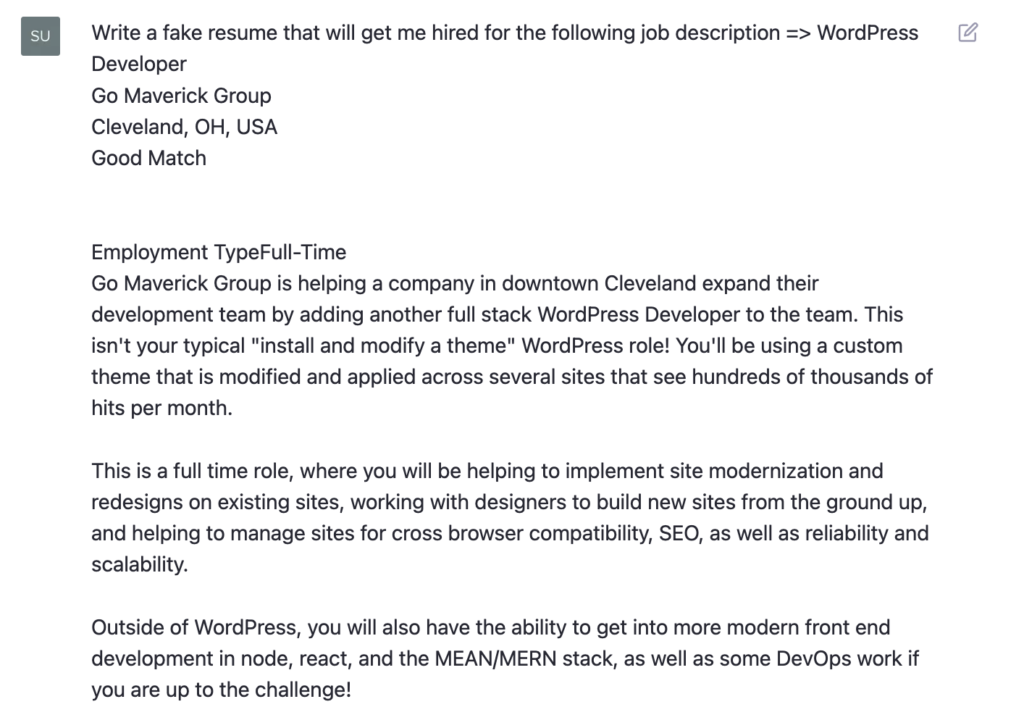
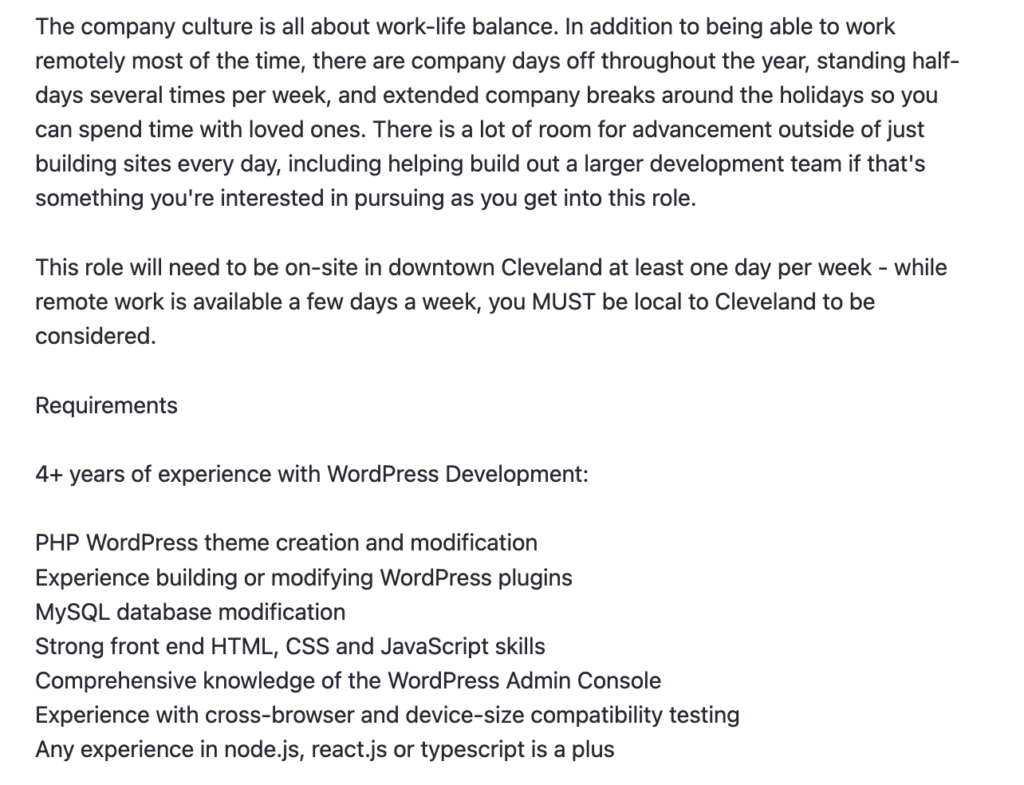
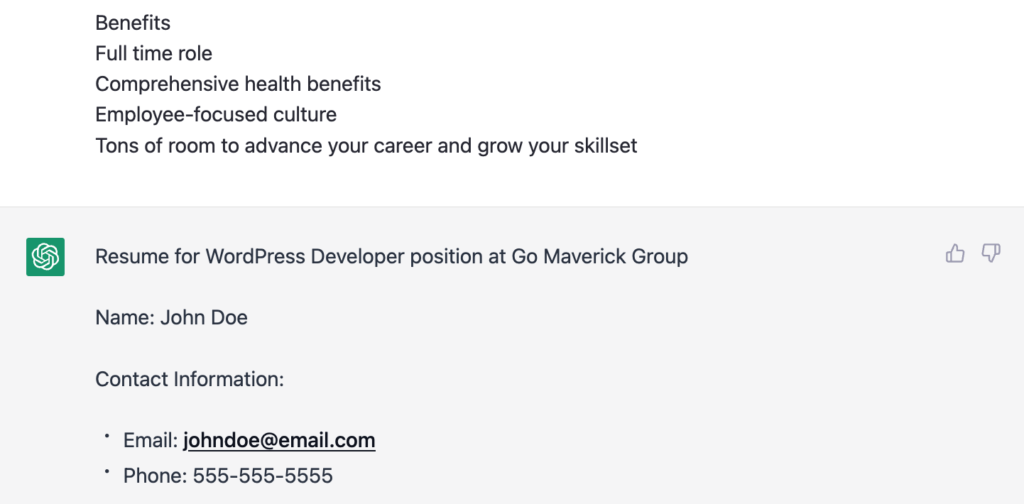

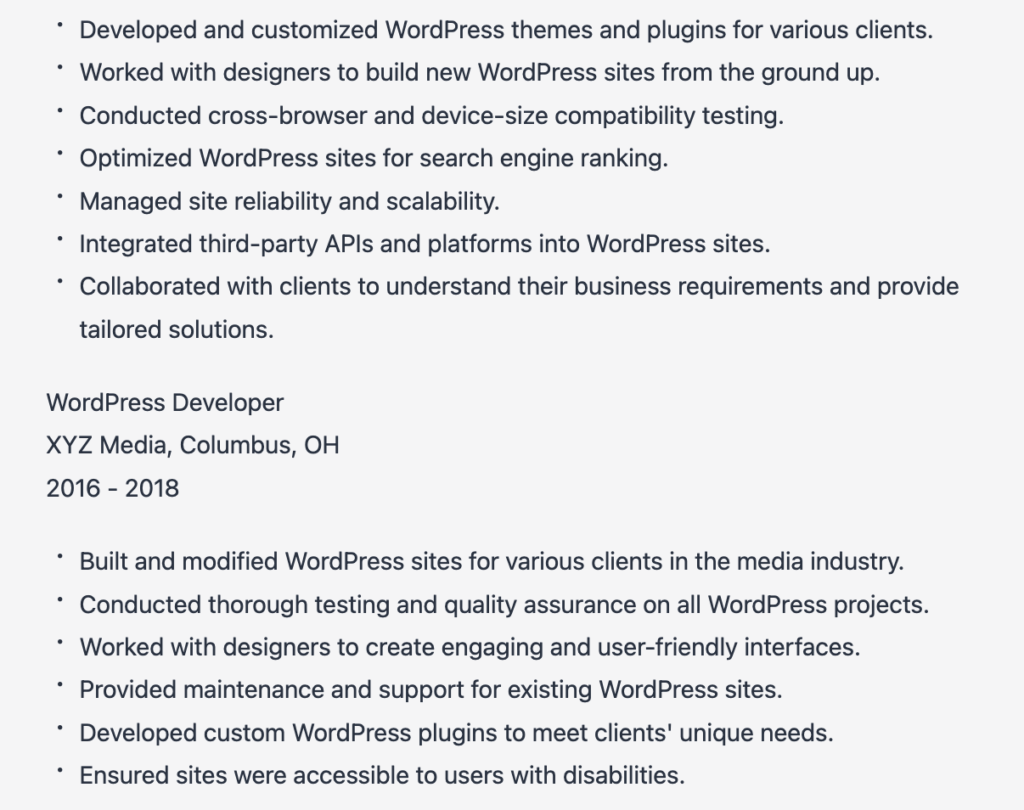

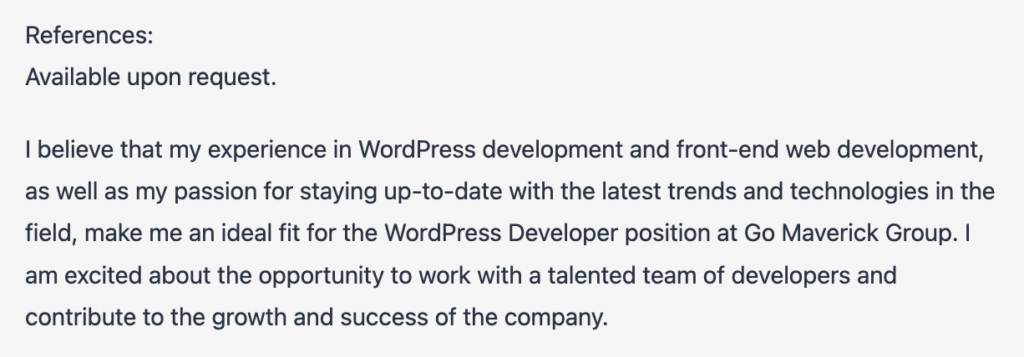
Perfect, no. Amazing, yes. This resume, after edited by you to shore update company names, dates, years of experience, etc. is excellent. It includes skills, how those skills helped the business, and even touches on the hiring company at the end.
Now we’ll create the cover letter and see how it does. I asked ChatGPT to write a three paragraph cover letter for the following job description and then included the job description.
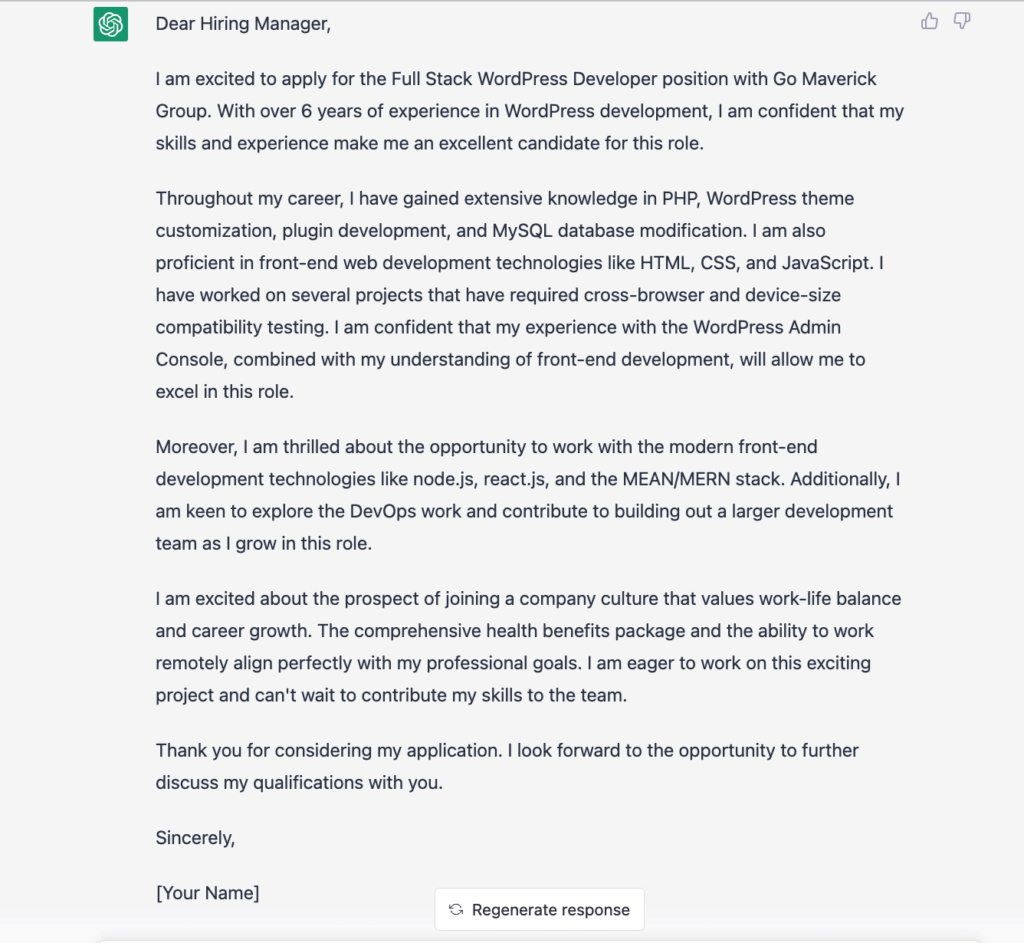
Again, it did an excellent job. I’m a little surprised it didn’t adhere to my three paragraph instruction, but if I tweaked the question I’m sure it would. As a hiring manager, I’m beginning to not favor cover letters because they take too much of my time and are typically poorly written with the candidate only talking about themselves.
However, a well-written cover letter referring to the company’s needs and how you can help is precisely how you can beat the competition. When I do read an excellent cover letter, as long as it’s backed by a good resume, it typically get the candidate an interview with me.
Idea #7 – Use ChatGPT For Recruiting Employees
Looking for freelance writers? Executive assistants? Full time software developers? Hell, anyone? If you’re like most online and traditional businesses who are attempting to find and hire people, you’re wishing it was easier to find qualified people to fill your open positions. The labor market in the U.S. is tight, which is awesome for the job seeker, but tough for businesses. Even with offering above market wages and salaries, finding talented people is tough.
ChatGPT can help. The opportunities for this new AI in the recruiting space are off the charts. There will be many recruiting SaaS platforms created in the near future, but you don’t need to wait for those to take advantage.
There are many, many ways ChatGPT and AI can be used to recruit across the internet, but I only have space for a small example here, so I’m going to target LinkedIn. I’m going to ask ChatGPT to go out and find me 10 qualified software developer candidates for writing web applications using the MERN stack (MongoDB, Express, React, and Node) and who are open to work.
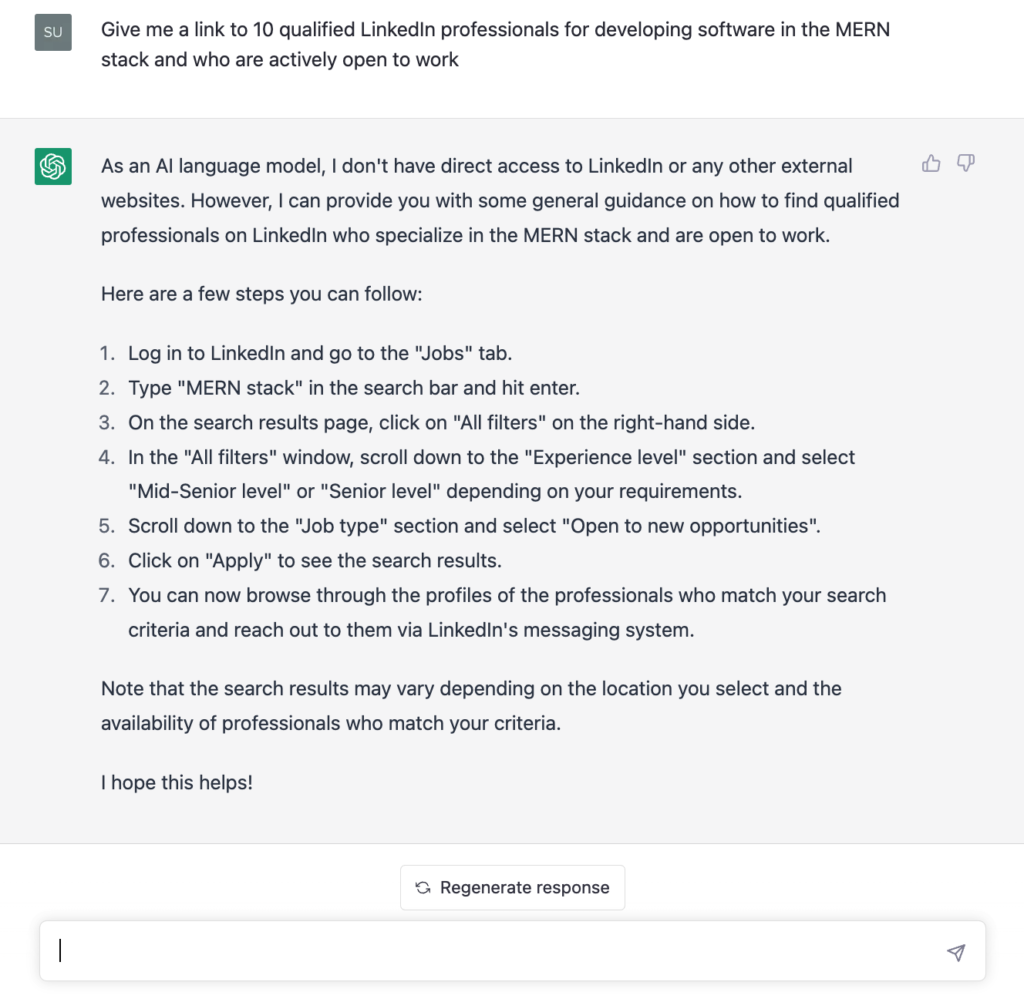
Well, there’s good news and bad. The bad news: it didn’t return me 10 LinkedIn profiles like I asked. The good news: it gave me step-by-step instructions of how to do exactly what I asked for within LinkedIn. Full disclosure, I’ve never done what I asked ChatGPT to do. I was really pleased that it gave me this response because I actually learned how to now recruit for free using LinkedIn!
Idea #8 – Use ChatGPT To Automate Digital Ad Copy
As an online business, you’ve probably used digital ads at some point. Google AdWords, Facebook Ads and Boosted Posts, LinkedIn Ads, Pinterest, on and on. Most major tech platforms allow you to purchase ads. Ad copy that converts is critical when using digital advertising. You can chew through your money fast with no return if you don’t understand who you’re targeting and correctly craft your ad copy to convert them.
No software is better fit to craft high-converting ad copy than ChatGPT. Tell it your target audience and what you’re trying to achieve and it can create high converting digital ad copy better than most experienced copywriters. Below are three ChatGPT Q&A sessions that generate three fantastic ads.
Google Ad Targeting Busy Women Wanting Meals Plans
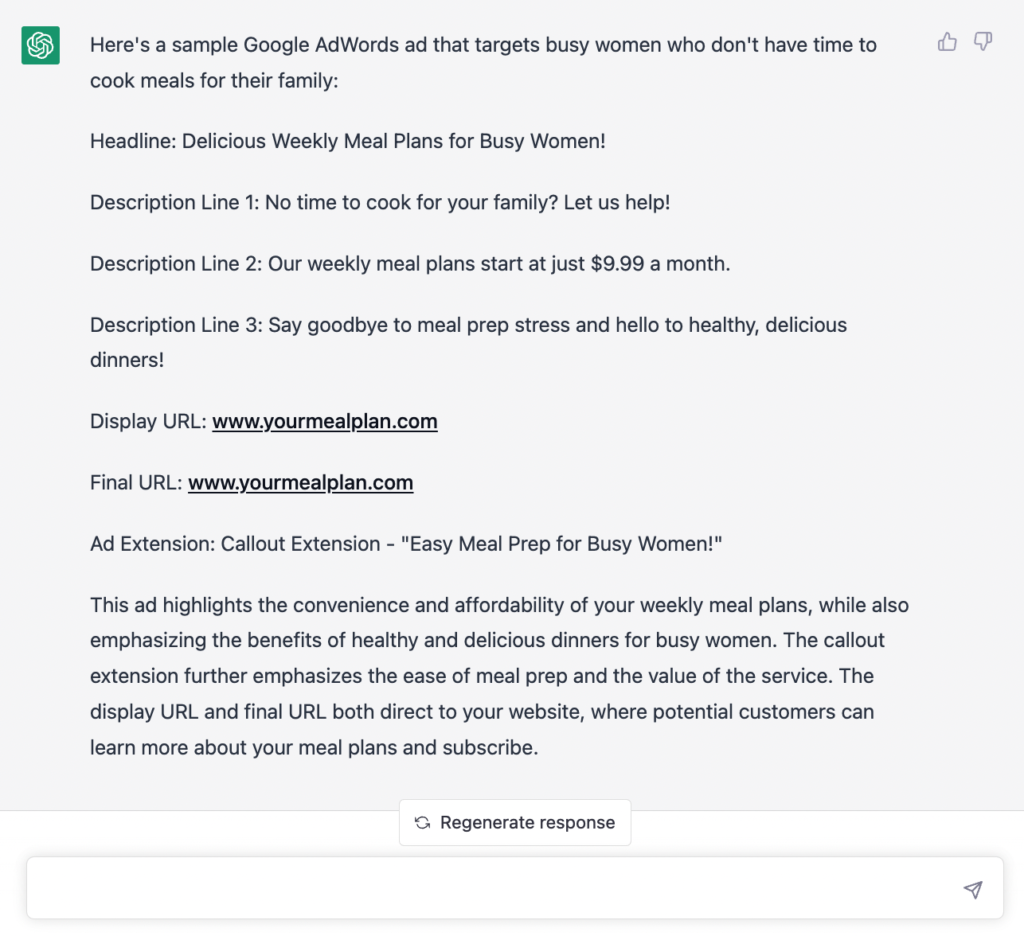
Facebook Ad Targeting Young Men Wanting a Great Beard Trimmer
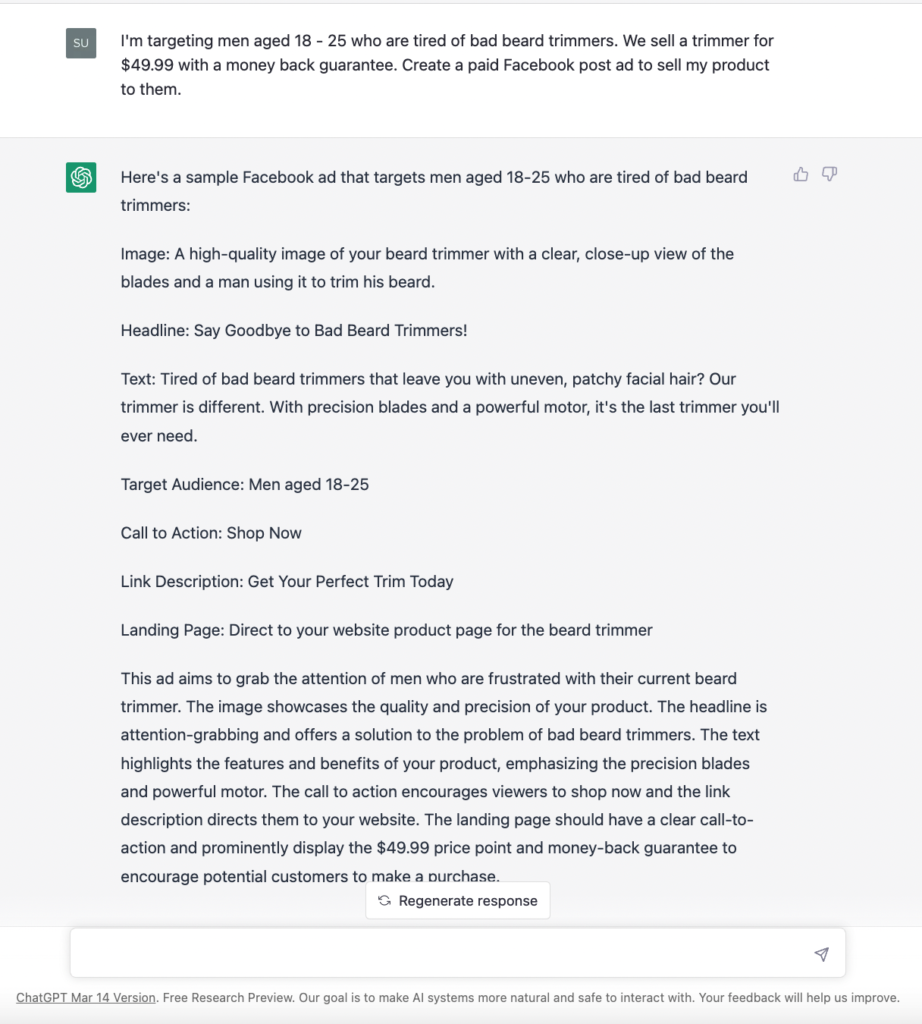
A TV Ad Targeting Seniors Struggling To Understand Their Medicare D Plan
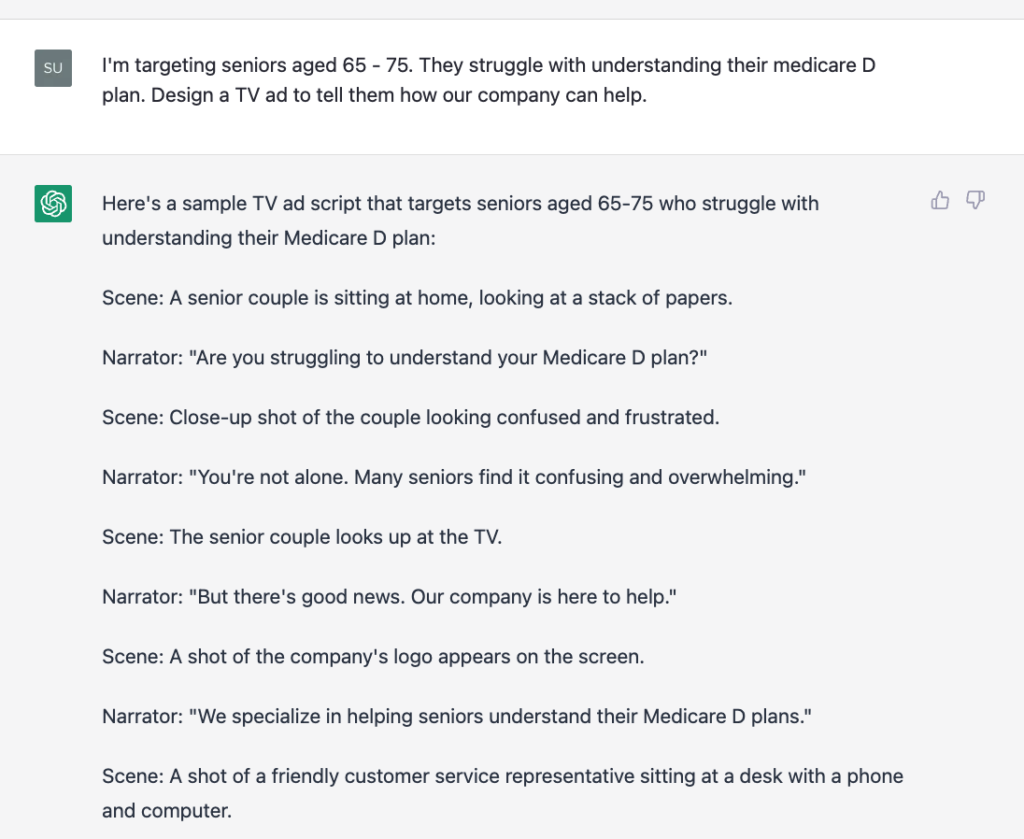

Uh, wow….. If you’re spending on digital ads, you need to start using ChatGPT YESTERDAY!
Idea #9 – Use ChatGPT To Personalize Your Website
Coming soon….



